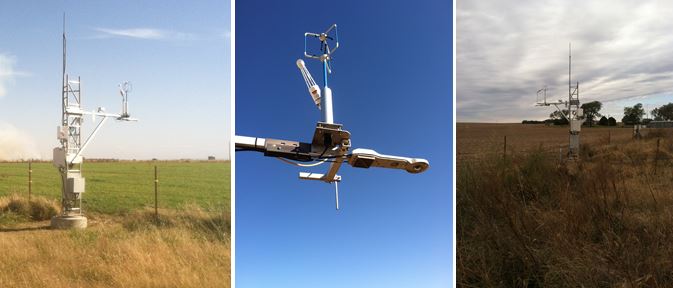Upgraded Eddy Correlation Flux Measurement Systems Streamline Data
Published: 23 March 2020
New sensors and microprocessors installed at seven Southern Great Plains sites

Eddy correlation flux (ECOR) measurement systems measure the transport of water vapor, carbon dioxide, heat, and momentum between the land and the atmosphere in 30-minute periods. The Atmospheric Radiation Measurement (ARM) user facility provides ECOR systems at its fixed and mobile atmospheric observatories around the world.
In late October 2019, ARM upgraded the seven ECOR systems across its Southern Great Plains (SGP) atmospheric observatory. The oldest system was installed in 2003, says Ryan Sullivan, ARM’s ECOR lead instrument mentor from Argonne National Laboratory in Illinois.
The upgraded systems have new sensors that are more sensitive to trace gas concentrations than their predecessors, which are too old for their manufacturer to service.
Uncorrected and corrected fluxes from the previous systems remain available in the ARM Data Center as two separate datastreams, 30ECOR and 30QCECOR. The Quality-Controlled Eddy Correlation Flux (QCECOR) value-added product corrects for “physical limitations in the system’s sensors and theoretical assumptions,” says Sullivan, and these data should be used when available. However, data from the upgraded ECOR systems do not need to run through QCECOR.
These systems now provide uncorrected and corrected fluxes in one datastream (ECORSF), thanks to the addition of an onboard microprocessor that applies routine eddy correlation corrections and additional quality control tests.
The upgraded systems are at SGP extended facilities E14 (Lamont, Oklahoma); E31 (Anthony, Kansas); E33 (Newkirk, Oklahoma); E37 (Waukomis, Oklahoma); E38 (Omega, Oklahoma); E39 (Morrison, Oklahoma); and E41 (Peckham, Oklahoma). ARM is considering ECOR upgrades at its other observatories.
Sullivan worked on the SGP project with David Cook, ARM’s previous lead mentor for the ECOR systems; and Evan Keeler, ECOR associate mentor. ARM SGP staff James Martin and David Swank helped with the installation.
Keep up with the Atmospheric Observer
Updates on ARM news, events, and opportunities delivered to your inbox
ARM User Profile
ARM welcomes users from all institutions and nations. A free ARM user account is needed to access ARM data.


















